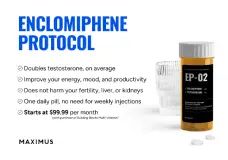It’s not quite as off-the-wall as it sounds. We know that as serum testosterone increases the 5α-reductase enzyme starts to saturate, leading to a reduced efficiency in DHT creation, illustrated thusly:

Even so, with high testosterone a lack of DHT is not going to be a problem; there’s still going to be a lot of it, likely at supraphysiological levels. A T/DHT imbalance is possible, though this would seem to be a more subtle problem.
However, what’s going on with other 5α-reductase-mediated processes? It seems possible that there are deleterious effects on these processes through competitive inhibition that increases with the level of testosterone. For example, there may be a reduction in the conversion of progesterone to dihydroprogesterone. This is cited as one of the possible reasons for finasteride-induced side effects. Clearly the overall effect is going to be less dramatic, as lack of DHT is likely a significant factor when finasteride is in play. Additionally, the effects on 5α-reductase activity from competitive inhibition are likely less drastic than those from finasteride. Nonetheless, with individual variability it seems plausible that some men will experience problems from this, which serves as a further reminder that high levels of testosterone are not necessarily benign.
Some comments by ChatGPT:
To be fair, it does mention some caveats:
Even so, with high testosterone a lack of DHT is not going to be a problem; there’s still going to be a lot of it, likely at supraphysiological levels. A T/DHT imbalance is possible, though this would seem to be a more subtle problem.
However, what’s going on with other 5α-reductase-mediated processes? It seems possible that there are deleterious effects on these processes through competitive inhibition that increases with the level of testosterone. For example, there may be a reduction in the conversion of progesterone to dihydroprogesterone. This is cited as one of the possible reasons for finasteride-induced side effects. Clearly the overall effect is going to be less dramatic, as lack of DHT is likely a significant factor when finasteride is in play. Additionally, the effects on 5α-reductase activity from competitive inhibition are likely less drastic than those from finasteride. Nonetheless, with individual variability it seems plausible that some men will experience problems from this, which serves as a further reminder that high levels of testosterone are not necessarily benign.
Some comments by ChatGPT:
In summary, it is entirely plausible that high levels of serum testosterone can competitively inhibit the conversion of other steroid substrates by 5α-reductase, including the conversion of progesterone to dihydroprogesterone. The structural similarities and abundance of testosterone in such scenarios create a scenario ripe for competitive inhibition. This is a fascinating area of research with potential implications for understanding various physiological and pathological conditions. …
To be fair, it does mention some caveats:
• Complexity: Hormonal regulation is highly complex, and many factors can influence the activity of 5α-reductase. This isn’t a simple “one substrate wins” scenario.
• Feedback Mechanisms: The body has negative feedback loops to regulate hormone production, so simply increasing testosterone wouldn’t necessarily cause a sustained reduction in other 5α-reductase products.
• Tissue Specificity: The effects could be tissue-specific since the levels and forms of 5α-reductase vary throughout the body.
















